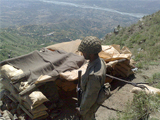Selective Counterterrorism in Pakistan
By Prem Mahadevan for ISN
Starting in May 2009, the Pakistani army launched a series of offensives against radical Islamist groups in the Swat and South Waziristan regions. More than 6,500 alleged Taliban fighters have been killed since then, and approximately 1,400 Pakistani civilians have died in terrorist attacks.
The international community has applauded the Pakistani army’s decision to take on the Taliban, overlooking the fact that the army’s counterterrorist strategy is highly selective. It only targets Taliban splinter groups that have an explicitly anti-Islamabad agenda and offers other radical Islamists the option of peaceful coexistence.
Such a segmented approach will not advance the objectives of international counterterrorist efforts, except in an indirect sense. Furthermore, implementation of this strategy has thus far failed even to protect Pakistan, due to systemic flaws in counterterrorism capabilities.
A mosaic of Islamist groups
Having supported far-right Islamist groups since the Soviet-Afghan War, the Pakistani state has considerable knowledge about the nature of the threat it currently faces. This has allowed the country’s premier intelligence agency, the Inter Services Intelligence (ISI), to map out the agendas of numerous terrorist groups. Working from an extensive database, it has formulated a wedge strategy, aiming to promote rifts between ‘good’ and ‘bad’ militants. The former encompass all Islamist militias which do not target the Pakistani security forces, while the latter is confined to groups with a history of attacking police and military personnel. Translated into operational reality, this means that only three terrorist groups are considered strategic adversaries of the Pakistani state: al-Qaida, the Mehsud Faction of the Pakistani Taliban and the sectarian group Lashkar-e-Jhangvi.
All other groups, including the Afghan Taliban, non-Mehsud factions of the Pakistani Taliban, India-centric groups and most sectarian groups, are unaffected by the ongoing military operations. Their survival is due to the very narrow terms according to which Islamabad has defined its counterterrorist objectives. Any Islamist group that does not attack the Pakistani state is left alone, even if it attacks targets across Pakistan’s western and eastern borders or indeed, religious minorities within Pakistan itself.
So far, 14 such peace deals have granted operational depth to the Afghan Taliban, thereby increasing its strike power. The Pakistani military and ISI have balanced out this policy by cooperating with operations against al-Qaida and protecting NATO supply lines. In the process, they have safeguarded their real strategic assets – the Afghan Taliban leadership.
Having invested in the Afghan Taliban from the mid 1990s, Islamabad views them as a hedge against Indian influence in Kabul. It has pressed for the rehabilitation of ‘moderate’ leaders among them and has tolerated the activities of their Pakistani allies. Such forbearance stems from the fact that most Pakistan-based Taliban groups have no interest in a confrontation with Islamabad, preferring to use Pakistani territory as a safe haven for launching attacks in Afghanistan. The only exception is the Mehsud Faction – a Pakistani Taliban group with strong al-Qaida connections.
Led by a Pashtun tribal leader called Hakimullah Mehsud, this faction has attacked Pakistani soldiers, policemen and civilians in alliance with the Lashkar-e-Jhangvi, a Punjab-based sectarian group. The Pakistani army’s operations in Swat and South Waziristan, although portrayed as strategic counteroffensives, were actually instinctive responses to the rising frequency of attacks from these two groups.
Divide and rule
Contrary to popular belief, Pakistani counterterrorist strategy does not rely on overt military action. Rather, it uses intelligence biographies to exploit interpersonal differences between Islamist leaders and prevent them from uniting toward a common purpose. Although the Mehsud Faction is currently being ground down by military operations, this has only happened after ISI officials bought off Pakistani Taliban leaders from the more powerful Waziri Faction.
Similarly, anti-Indian militias like the Lashkar-e-Toiba (LeT) have been dissuaded from developing a domestic agenda by the vice-like grip that ISI has over their top leaders. As long as radical Islamists adhere to the political code prescribed for them by the ISI and desist from attempting regime change within Pakistan, they are left free to operate against targets outside Pakistani borders.
High-visibility counterterrorist operations such as Rah-e-Rast (launched in Swat, May 2009) and Rah-e-Nijat (South Waziristan, June 2009-present) are prioritized less than covert negotiations with Islamist powerbrokers. For instance, to break the nexus between Lashkar-e-Jhangvi and the Mehsud Faction, the ISI has coopted the Tablighi Jamaat, an evangelistic group that has been linked to numerous terrorist plots in the West. Dominated by former officers of the Pakistani military, the Tablighi Jamaat has denounced the Taliban as ‘unIslamic,’ thereby limiting the Mehsud Faction’s appeal within Punjab. At the same time, the Jamaat is also suspected by western intelligence agencies of being a gateway for recruitment to jihadist groups, due to its fundamentalist agenda. Should the Pakistani government continue to rely on one Islamist group to offset another, it risks creating new problems even as it contains old ones.
Yet, the fact also remains that the Pakistani security establishment as a whole is ill-equipped for the task of ‘hard’ counterterrorism. The police force is poorly motivated, which is unsurprising given that suicide bombers’ families are paid more compensation by terrorist groups than slain policemen’s families are paid by the state.
The firepower available to terrorist groups, much of it procured under the benevolent gaze of the ISI, has placed the police at a tactical disadvantage during search operations. Coordination between security agencies is poor, because one agency’s intelligence target is usually another’s intelligence asset. The links between jihadist groups and organized crime syndicates, particularly in Punjab, mean that foreknowledge of police action can easily be purchased from corrupt officials. By adopting a soft, non-confrontational line against terrorism therefore, the Pakistani state is seeking to avoid having its own weakness brutally exposed by terrorist groups.

